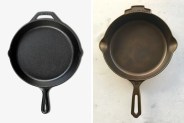Thanks to a wealth of virtually useless marketing speak, buying a gas grill for the first time is a daunting task. What is a BTU? How much cooking space is enough? Is there a difference between propane and natural gas? More simply, what do you really get when you open up your wallet for a new gas grill? Comparing the Home Depot curbside staple three-burner Dyna-Glow grill, sold for just above $100, to Weber’s upscale Genesis II S-335 option, we find out.
Temperature Potential
The chief concern with all gas grills is maximum temperature. Most gas grills struggle to breach the 400 to 500 degree barrier, which makes grilling grocery store steaks, pork chops and other meats that aren’t excessively thick challenging. You want a crust, but the temperature isn’t high enough to deliver one before the meat is cooked through. This is also the chief difference between gas grills and their charcoal counterparts, which get very hot.
Though the Dyna-Glow and the Weber are both propane gas grills with three burners, they are in different leagues in this realm. The Dyna-Glow is outfitted with three main burners that operate at 8,000 BTUs per hour, while the Weber is armed with a trio of 13,000 BTU per hour burners. And though BTUs are not a very reliable method for gauging grill potential, they’re an OK start. In the case of the Weber and the Dyna-Glow, the numbers bear out — the Genesis climbs into the 600s, while the Dyna-Glow peaked in the mid-400s. The difference is critical, and that’s without factoring in the Weber’s infrared burner — what they call the “Sear Station” — which pushes past 800 degrees, which is charcoal fire territory.

